In late May, after attending a nephew’s wedding near Venice, then exploring Italy’s northern Dolomite Mountains – I considered how best to spend the rest of the trip.
I looked at a map. Having visited Bologna and Verona years ago, I was drawn to the city of Modena.
Modena? Isn’t that renowned for balsamic vinegar?
Indeed. As well as for manufacturing Ferrari, Lamborghini, and Maserati cars. It’s also within the province of Emilia-Romagna – famed for exquisite food, as well as Lambrusco wine. Cars? No big deal. Good food and wine?
I drove there in two hours.
Whereas Sangiovese wines of Tuscany (Chianti, Brunello) are often rich, red, and tannic, the province of Emilia-Romagna has – Lambrusco! – pink or red, fresh and frothy. Serve in a chilled glass.
Modena’s large open plaza – Piazza Grande – resembles that of many ancient Italian cities, surrounded by concentric ring roads pierced by perpendicular avenues shooting toward the center like spokes to a bicycle hub. After parking, I walked ten minutes before happening – by chance – across a splendid wine bar.
Fabrizio, the manager of Modena’s wine bar Enoteca Athenaeum told me that Lambrusco, “is an easy wine, like Prosecco.” During a late Thursday afternoon we listened to music by the Doors, U2, and Buffalo Springfield while he explained how most – over 90 percent – of Lambrusco sparkling wine is made using the Charmat Method, as opposed to the Classical Method (also known as Metodo Classico, or Méthode Champenoise), which is used to make Champagne and several other sparklers, including Franciacorta from Italy, Cava from Spain, and Crémant from France.
Both methods require adding additional yeast and sugar to the wine after it has undergone primary fermentation (where sugar first transforms into alcohol) to initiate a secondary fermentation. In the Charmat Method, this fermentation is speeded up in pressure controlled tanks (often steel), whereas in the Classical Method it takes place more gradually in the bottle (the sugar and yeast are added to the bottle before it is capped).
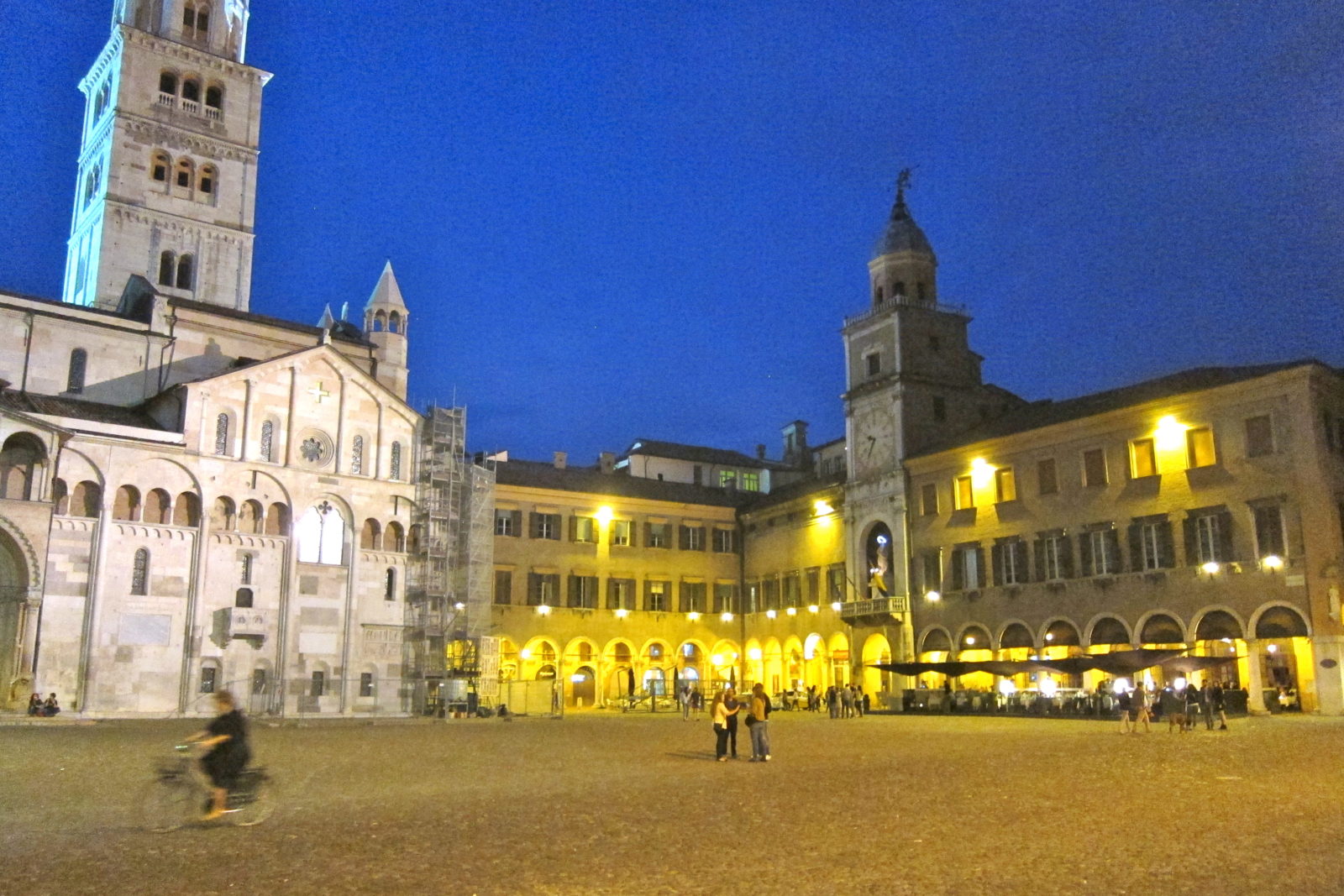
The Charmat method produces fresh wines that are rich with fruit and floral aromas, but which lack complexity found in Champagne (or other Classical Method products) – which typically undergo longer secondary fermentations – often 24 months or more. Lambrusco can be frizzante (fizzy) or spumante (sparkling). Though bubbles in a Lambrusco are often larger than those found in sparkling wines made using the Classic Method, the overall pressure in the bottle is, paradoxically, often less – resulting in little or no foaming over the rim on opening.
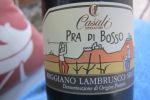 Lambrusco is the name of both grape and wine. True Lambrusco is neither sweet or white, and contains at least 11 percent alcohol. There are over a dozen Lambrusco grape varieties (and dozens of clones), and wine is made primarily from six of them. Additionally (and confusingly) there are at least eight separate separate Denominazione di Origine Controllata (DOC) regions producing Lambrusco wine. Be wary – some of the grapes and the DOC regions share the same names.
Lambrusco is the name of both grape and wine. True Lambrusco is neither sweet or white, and contains at least 11 percent alcohol. There are over a dozen Lambrusco grape varieties (and dozens of clones), and wine is made primarily from six of them. Additionally (and confusingly) there are at least eight separate separate Denominazione di Origine Controllata (DOC) regions producing Lambrusco wine. Be wary – some of the grapes and the DOC regions share the same names.
Fabrizio chilled a wine glass by swirling ice cubes inside, then filled it with Lambrusco di Modena, assuring me this was from the vicinity of the city. He referred to other varieties of Lambrusco in his English (learned while visiting America) as being “from the suburbs.”
Below is a brief description of four of the main grape varieties (not clones) used to make Lambrusco wines.
- Lambrusco di Sorbara – From north of Modena, producing high quality, dry to medium dry fragrant wines.
- Lambrusco Salamino di Santa Croce – At least four Lambrusco grape varieties come from this, the largest Lambrusco producing and exporting region, with both light-colored wines, and drier, darker wines. Both Sorbara and Salamino Lambrusco grapes are often cultivated on plains, often in proximity to each other.
- Lambrusco Grasparossa di Castlevetro – This Lambrusco grape comes from a small hilly region 20 kilometers south of Modena, and produces deep purple, tannic, dry wines. Not only the leaves, but the stalks turn rich red during autumn. The quantity of production is relatively low, but the quality is high. The wine is intensely ruby-red and violet, with its foam the same color. In general, fruit and acidity are reasonably balanced, and there is often bitter aftertaste (not unpleasant). For many, either this or Lambrusco di Sorbara produce the cream of the crop of Lambrusco wines.
- Lambrusco di Modena – This is what Fabrizio served – decent wine, decent price, made from grapes produced in various regions close to Modena. The quality has elevated over time enough to result in the inclusion of the wine in DOC status.
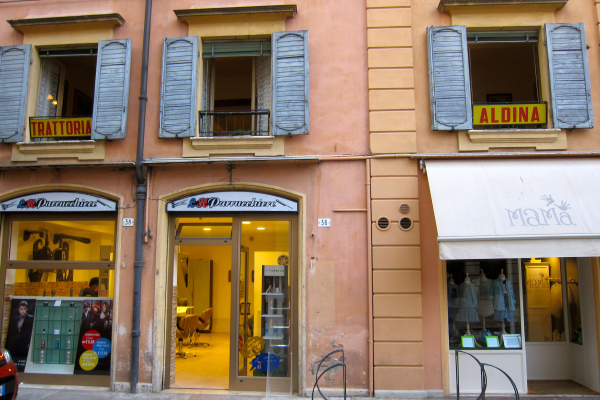
Lambrusco wine turned into a huge, welcome surprise. Sit in the sun on a summer afternoon, fill your glass with frothy, purple, and delicious, low-alcohol vino and enjoy it with cuts of prosciutto, olives, and cheese. You’ll enjoy. This fizzy wine goes well with rich foods from appetizers through desserts, including sweet sausage, salami, Parmigiano Reggiano cheese, lasagna, tortellini, and all types of pasta. As the Italian writer and musical composer Bruno Barilli said, “il Lambrusco fa boom nello stomaco,” meaning – obviously – that the wine goes ‘boom’ in the stomach.
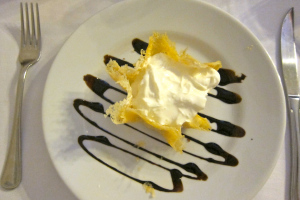
According to a book I bought in a Modena bookstore, written by Sandro Bellei and titled – La Rivincita del Lambrusco – Il vino più venduto nel mondo (The Revenge of Lambrusco – the best selling wine in the world), the word ‘Lambrusco’ derives from two Latin words – labrum, meaning margin, and ruscum, meaning wild plant – indicating a grape that once grew wild along forest edges. Romans harvested these grapes from Apennine Mountain slopes. Before them, Etruscans also made wine from Lambrusco grapes.
Between 1960 and 1970, the grape grew in international stature, and in the 70’s Lambrusco invaded the US market. Today it is largely exported to the US, UK, Germany, Russia, Japan, China, and Brazil. Much of this exported wine is a blend of Lambrusco grapes from at least eight separate Denominazione di Origine Controllata (DOC) regions, and can contain up to 15 percent of juice from non-Lambrusco grapes. Fortunately, the benefits of genuine Lambrusco are replacing wines that in the recent past were sold overseas (many in the US) which were overly sweet and fizzy, as Eric Asimov described in his New York Times piece. The better and genuine Lambrusco wines are mentioned in an article about wines that are best to drink young in a recent piece by Will Lyons in the Wall Street Journal.
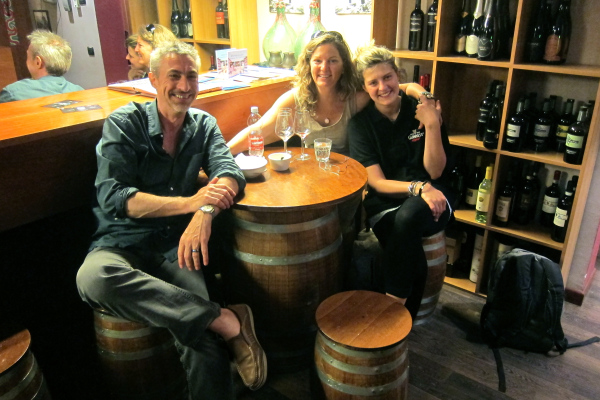
Words and Wine –
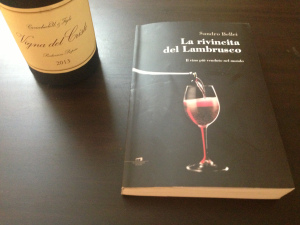 Sandro Bellei’s paperback book (mentioned above) is titled La Rivincita del Lambrusco (The Revenge of Lambrusco). It includes a series of independent essays about Lambrusco. Written in Italian (though approachable if you understand Spanish or French), the book is a love song to a grape and wine, as well as to excellent food, rich history, and a culture that takes pride in enjoying the beauty of long meals and slow drinks with companions.
Sandro Bellei’s paperback book (mentioned above) is titled La Rivincita del Lambrusco (The Revenge of Lambrusco). It includes a series of independent essays about Lambrusco. Written in Italian (though approachable if you understand Spanish or French), the book is a love song to a grape and wine, as well as to excellent food, rich history, and a culture that takes pride in enjoying the beauty of long meals and slow drinks with companions.
Different chapters describe types of Lambrusco grapes, history and marketing of the wine, and also include recipes, a long poem, and even an essay on how well Lambrusco pairs with sushi.
Enjoy!
Harvest and Chopping Block –
Here is the translated introductory paragraph from the book titled i Sapori dell’ Emilia (The Flavors of Emilia), by Ambra Ferrari.
“Sundays in summer, when the city is quiet and deserted, about noon I leave the house and go hunting for perfumes, seeking scents of the kitchen. On weekdays it’s impossible to catch them, as they are confused among a thousand other smells – the scent of meat sauce and broth, so gentle and delicate, cannot withstand the bully of car fumes. I wander streets and sniff the air like a bloodhound. If I take a slight hint of foods I do not let them get away. I follow, with patience and expertise, into the heart of old houses and finally stand with eyes half-closed in the hallways of those who know lasagna noodles.”
And below is a dessert recipe from the book, listed with a recommended wine to match.
Modena Bonnissima Pie
Ingredients –
- 5 cups (500 grams) sifted flour
- 1 cup (200 grams) granulated sugar
- 4 egg yolks
- grated peel from 1/2 a lemon
- 3/4 cup (250 grams) melted honey
- 2 cups (250 grams) chopped walnut kernels
- 1 small glass of rum
Steps –
- Mix the flower, sugar, butter, egg yolks, and lemon peel.
- Divide this dough in two.
- Take one half of the dough and use it to line a buttered baking pan.
- Mix the melted honey, chopped walnut kernels, and rum.
- Pour this honey nut mixture over the dough in the pan, then level it with a knife blade.
- Cover this with the remaining dough.
- Bake at 350 to 375 (medium heat) for about 30 minutes.
Finally –
Serve with Lambrusco di Sorbara Dolce (sweet) wine.
Finally – can you take 45 seconds to take a survey to help improve this site, so it gives you more of what you want? Thanks.
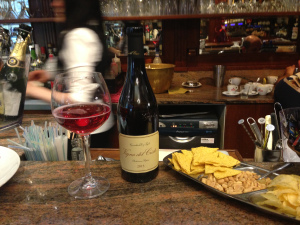
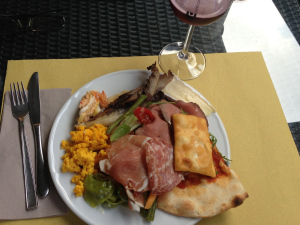
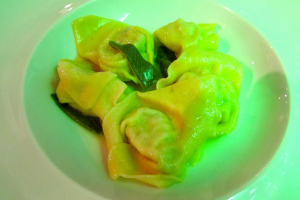

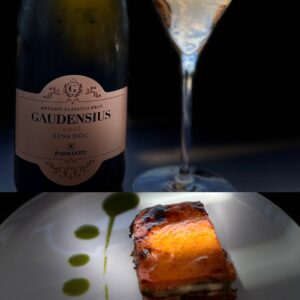

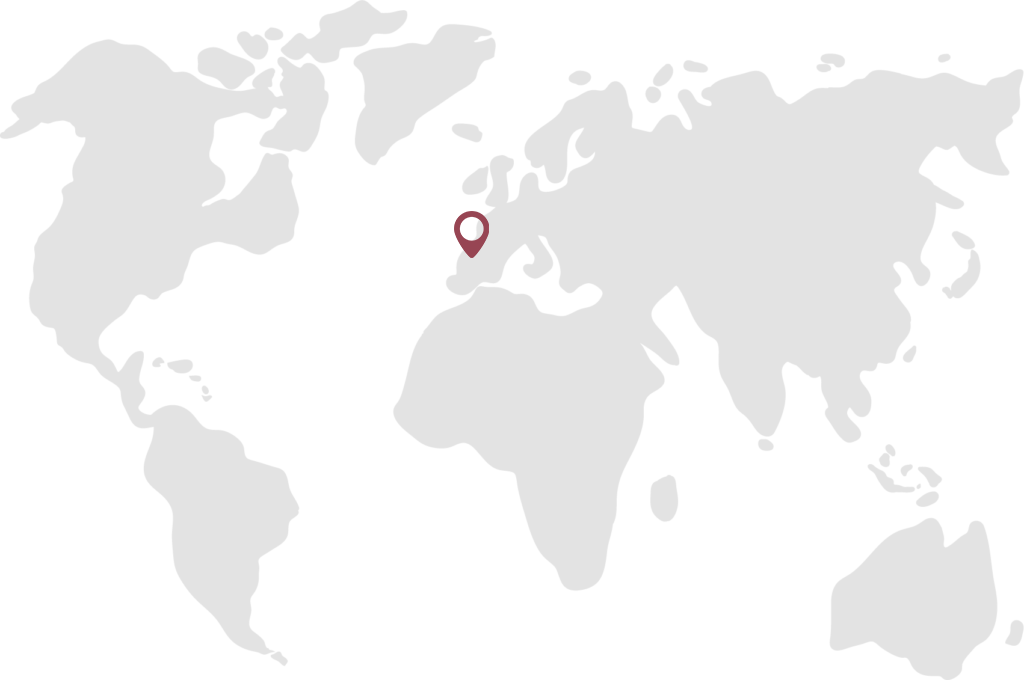
Chrissie
18 Jun 2014Very interesting, thanks Tom! I can’t say I know much about Lambrusco, since the only examples available here are cheaper, supermarket offerings, no doubt similar to what has been seen in the US. I look forward to getting the chance to seek out some of the better examples this summer in Bella Italia. Isn’t it such an incredible country!
vinoexpressions
19 Jun 2014Thanks Chrissie! Yes, you are SO well poised to visit both France and Italy from where you are. Enjoy your explorations! In the meantime I’ll make do with local cookbooks from those regions to remind me of la dolce vita.